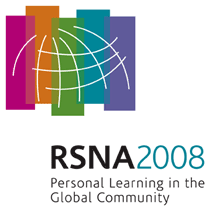
Abstract Archives of the RSNA, 2008
Luis Salgueiro Guimaraes MD, Presenter: Nothing to Disclose
Joel Garland Fletcher MD, Abstract Co-Author: Research grant, Siemens AG
Grant, E-Z-EM, Inc
License agreement, General Electric Company
Lifeng Yu PhD, Abstract Co-Author: Research grant, Xoran Technologies, Inc
Hassan Siddiki MD, Abstract Co-Author: Nothing to Disclose
James E. Huprich MD, Abstract Co-Author: Nothing to Disclose
David Maitland Hough MD, Abstract Co-Author: Nothing to Disclose
Robert Perry Hartman MD, Abstract Co-Author: Committee member, American Medical Systems
Consultant, Siemens AG
Cynthia H. McCollough PhD, Abstract Co-Author: Research grant, Siemens AG
Research grant, RTI Electronics AB
Research grant, Bayer AG
et al, Abstract Co-Author: Nothing to Disclose
Dual energy CT (DECT) utilizes low (80 kV) data, which enhances iodine signal at contrast-enhanced abdominal CT; however, the diagnostic image quality of 80 kV images is largely constrained by tube current limitations and patient size. Our purpose was to determine CT acquisition parameters and patient size that result in acceptable quality of 80 kV images for abdominal DECT.
Retrospective review of contrast-enhanced, dual-source abdominal DECT scans (using 80 kV for the reduced FOV tube) was performed, noting detector configuration, with all scans reconstructed using 2-3 mm slice width. A GI radiologist examined images at specified locations in the middle of the liver, pancreas, kidneys, and at the level of the TI, grading overall image quality (1=excellent to 5=severe degradation) and image artifacts/reader confidence (1=no artifacts/high confidence to 5= severe artifacts resulting in nondiagnostic study). The AP and lateral dimensions of the patient were measured and summed at each level. Detector configuration and patient sizes that resulted in unacceptable image quality and artifact rankings (i.e., ≥4) were determined.
14 x 1.2 mm detector configuration resulted in markedly fewer scans with unacceptable image quality and artifacts compared to 64 x 0.6 mm (20% vs 44%, p<0.05). Mean image quality and mean artifacts/confidence scores were significantly different for different organs (p < 0.05; kidney> TI> pancreas > liver). Median patient sizes (sum of AP and lateral measurements) that resulted in unacceptable image quality and artifacts using for the 1.4 mm and 0.6 mm detector configurations for liver were (67 & 65 cm, respectively); pancreas (75 & 67 cm); kidney (64 & 67 cm); bowel (71 & 68 cm).
1. Use 14 x 1.2 mm detector configuration at contrast-enhanced abdominal DECT results in significantly better image quality than 64 x 0.6 mm configuration. 2. Image quality and artifacts/reader confidence are related to the patient size as well as the organ of interest. 3. In large patients image artifacts can render low kV images unacceptable, limiting the use of abdominal DECT in these patients.
Patient size, detector configuration, and, to a lesser extent, organ of interest, must be considered when performing abdominal dual-energy CT.
Guimaraes, L,
Fletcher, J,
Yu, L,
Siddiki, H,
Huprich, J,
Hough, D,
Hartman, R,
McCollough, C,
et al, ,
Appropriate Patient Selection for Abdominal Dual Energy CT: Relationship between Patient Size and Image Quality. Radiological Society of North America 2008 Scientific Assembly and Annual Meeting, February 18 - February 20, 2008 ,Chicago IL.
http://archive.rsna.org/2008/6010754.html

